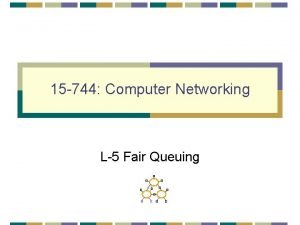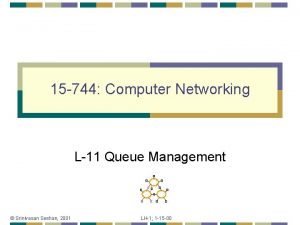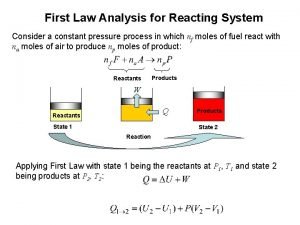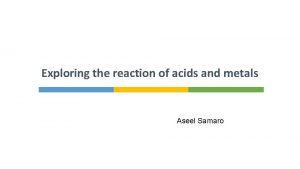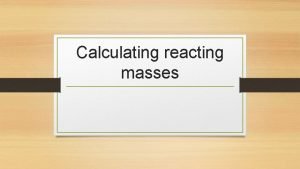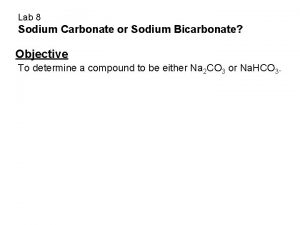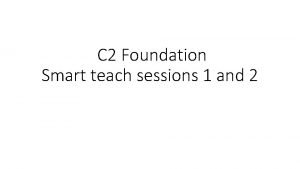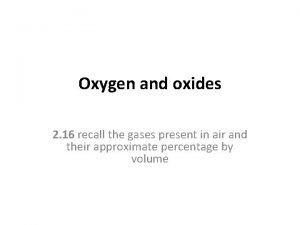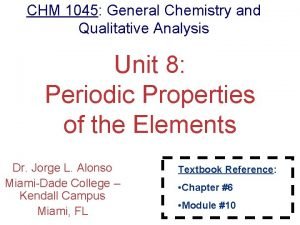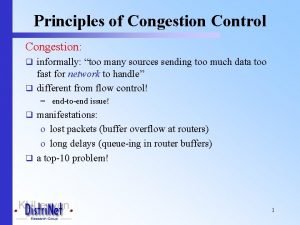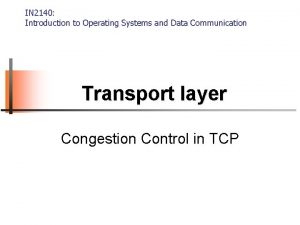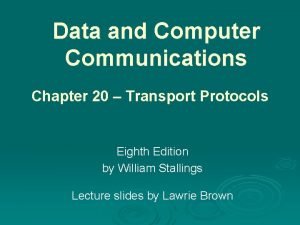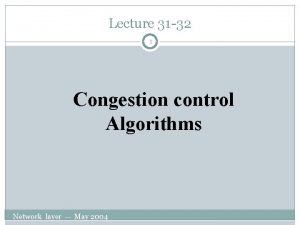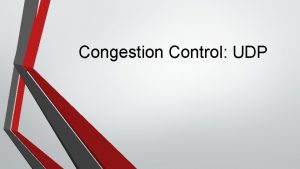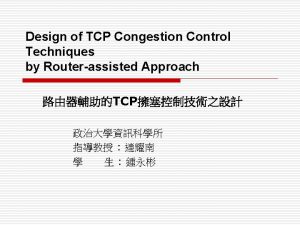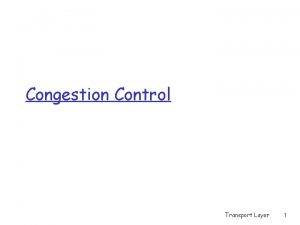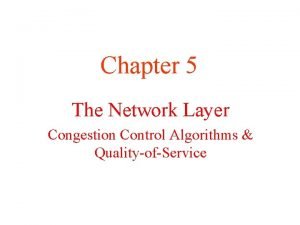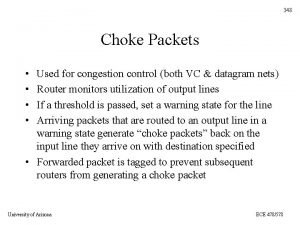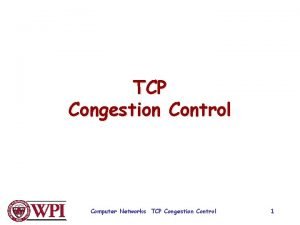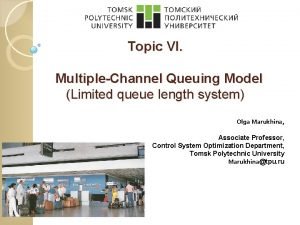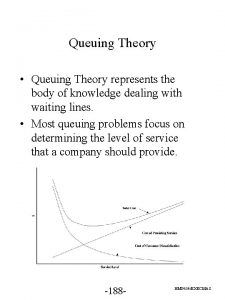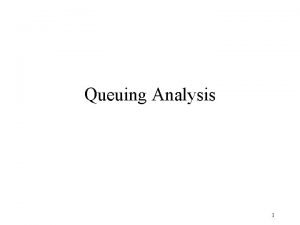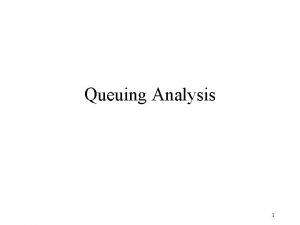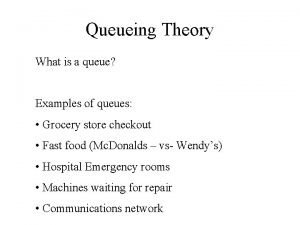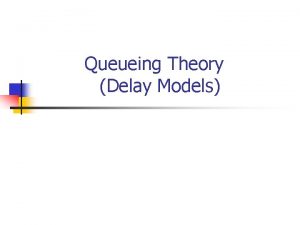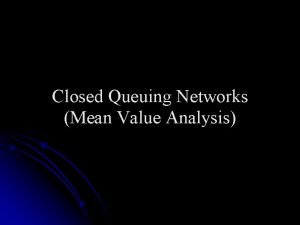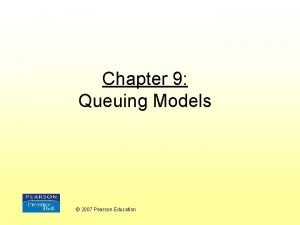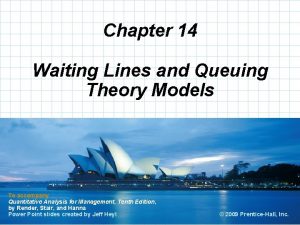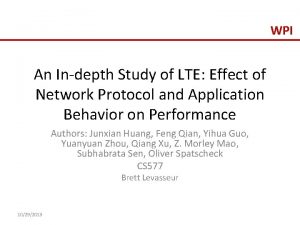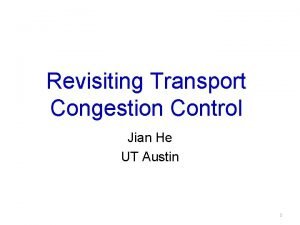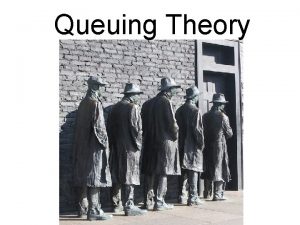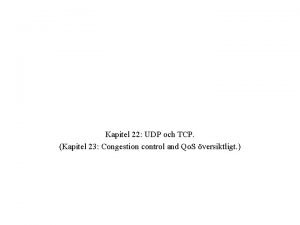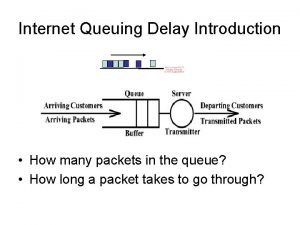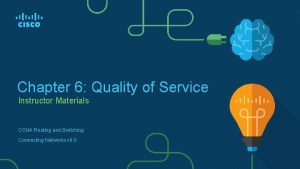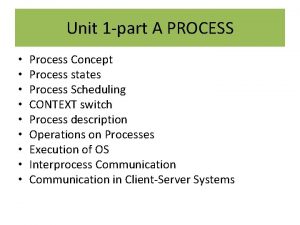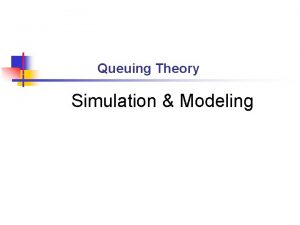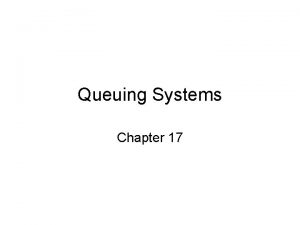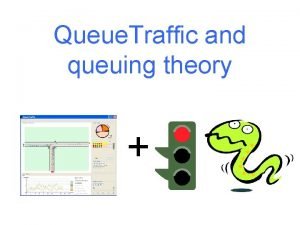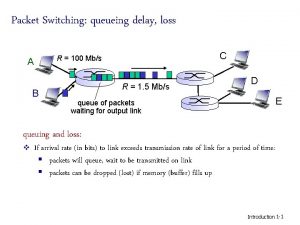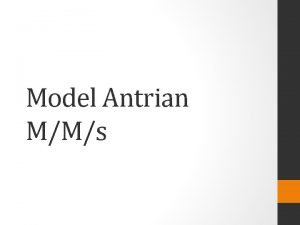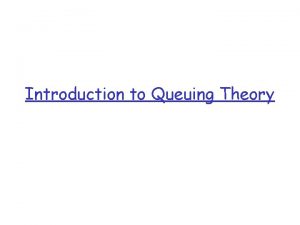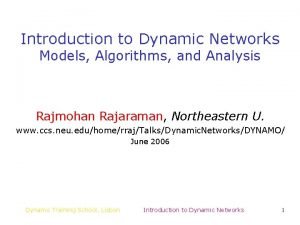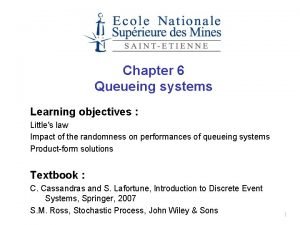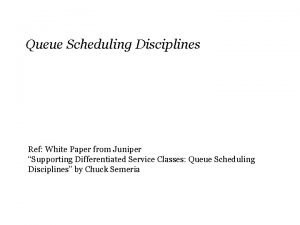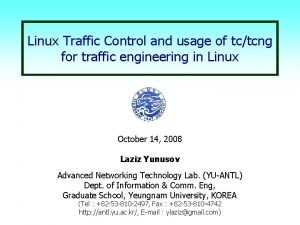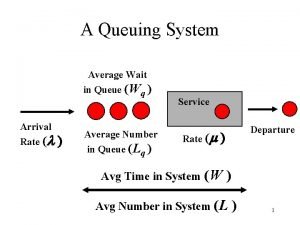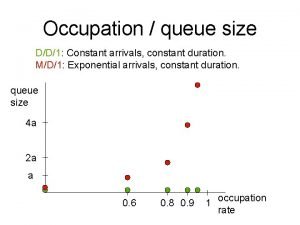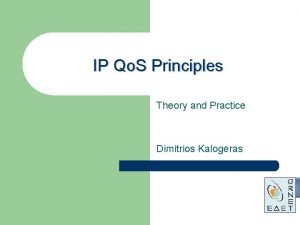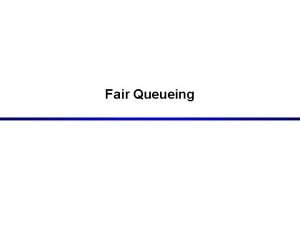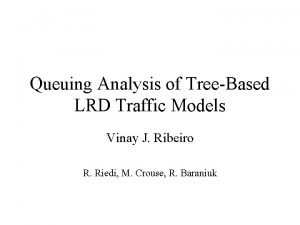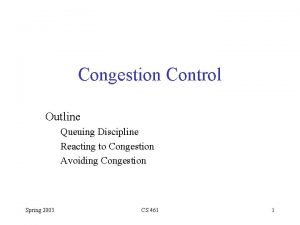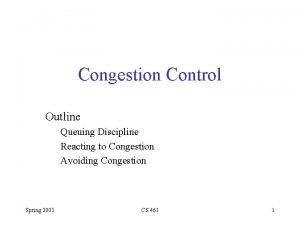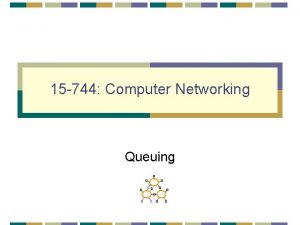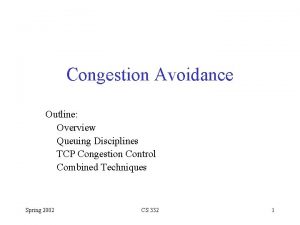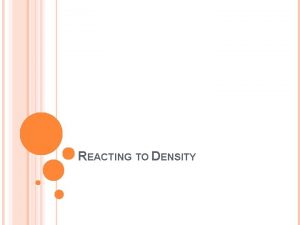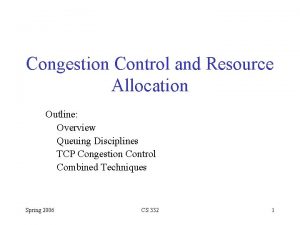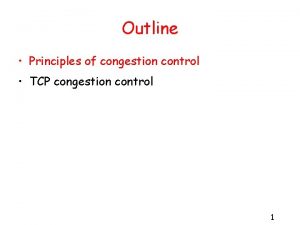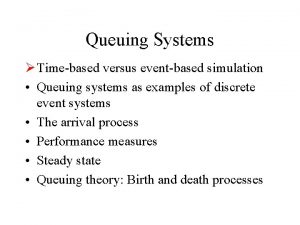Congestion Control Outline Queuing Discipline Reacting to Congestion





































































- Slides: 69

Congestion Control Outline Queuing Discipline Reacting to Congestion Avoiding Congestion Readings: Chapter 6 6/3/2021 my. KRcongestion 1

Goals of Today’s Lecture • Principles of congestion control – Learning that congestion is occurring – Adapting to alleviate the congestion • TCP congestion control – Additive-increase, multiplicative-decrease – Slow start and slow-start restart • Related TCP mechanisms – Nagle’s algorithm and delayed acknowledgments • Active Queue Management (AQM) – Random Early Detection (RED) – Explicit Congestion Notification (ECN) 6/3/2021 my. KRcongestion 2

Resource Allocation vs. Congestion Control • Resource allocation – How nodes meet competing demands for resources – E. g. , link bandwidth and buffer space – When to say no, and to whom • Congestion control – How nodes prevent or respond to overload conditions – E. g. , persuade hosts to stop sending, or slow down – Typically has notions of fairness (i. e. , sharing the pain) 6/3/2021 my. KRcongestion 3

Flow Control vs. Congestion Control • Flow control – Keeping one fast sender from overwhelming a slow receiver • Congestion control – Keep a set of senders from overloading the network • Different concepts, but similar mechanisms – TCP flow control: receiver window – TCP congestion control: congestion window – TCP window: min{congestion window, receiver window} 6/3/2021 my. KRcongestion 4

Issues • Two sides of the same coin – pre-allocate resources so at to avoid congestion – control congestion if (and when) it occurs • Two points of implementation – hosts at the edges of the network (transport protocol) – routers inside the network (queuing discipline) 6/3/2021 my. KRcongestion 5

Three Key Features of Internet Service Model • Packet switching – A given source may have enough capacity to send data – … and yet the packets may encounter an overloaded link • Connectionless flows – No notions of connections inside the network – … and no advance reservation of network resources – Still, you can view related packets as a group (“flow”) – … e. g. , the packets in the same TCP transfer • Best-effort service – No guarantees for packet delivery or delay – No preferential treatment for certain packets 6/3/2021 my. KRcongestion 6

Congestion is Unavoidable • Two packets arrive at the same time – The node can only transmit one – … and either buffer or drop the other • If many packets arrive in a short period of time – The node cannot keep up with the arriving traffic – … and the buffer may eventually overflow 6/3/2021 my. KRcongestion 7

Causes/costs of congestion: scenario 1 two senders, two receivers one router, infinite buffers output link capacity: R no retransmission throughput: lout Host A unlimited shared output link buffers Host B delay R/2 lout § § original data: lin R/2 large delays as arrival rate, lin, approaches capacity v § maximum per-connection 6/3/2021 throughput: R/2 my. KRcongestion 8

Causes/costs of congestion: scenario 2 § one router, finite buffers § sender retransmission of timed-out packet • application-layer input = application-layer output: lin = lout ‘ • transport-layer input includes retransmissions : lin lin : original data l'in: original data, plus lout retransmitted data Host A Host B 6/3/2021 finite shared output link my. KRcongestion buffers 9

Causes/costs of congestion: scenario 2 lout idealization: perfect knowledge § sender sends only when router buffers available R/2 lin : original data l'in: original data, plus copy lin R/2 lout retransmitted data A Host B 6/3/2021 free buffer space! finite shared output link my. KRcongestion buffers 10

Causes/costs of congestion: scenario 2 Idealization: known loss packets can be lost, dropped at router due to full buffers § sender only resends if packet known to be lost lin : original data l'in: original data, plus copy lout retransmitted data A Host B 6/3/2021 no buffer space! my. KRcongestion 11

Causes/costs of congestion: scenario 2 dropped at router due to full buffers § sender only resends if packet known to be lost R/2 when sending at R/2, some packets are retransmissions but asymptotic goodput is still R/2 (why? ) lout Idealization: known loss packets can be lost, lin : original data l'in: original data, plus R/2 lout retransmitted data A Host B 6/3/2021 free buffer space! my. KRcongestion 12

Causes/costs of congestion: scenario 2 § packets can be lost, dropped at router due to full buffers § sender times out prematurely, sending two copies, both of which are delivered lin timeout copy l'in A Host B 6/3/2021 R/2 when sending at R/2, some packets are retransmissions including duplicated that are delivered! lout Realistic: duplicates lin R/2 lout free buffer space! my. KRcongestion 13

Causes/costs of congestion: scenario 2 § packets can be lost, dropped at router due to full buffers § sender times out prematurely, sending two copies, both of which are delivered R/2 when sending at R/2, some packets are retransmissions including duplicated that are delivered! lout Realistic: duplicates lin R/2 “costs” of congestion: § more work (retrans) for given “goodput” § unneeded retransmissions: link carries multiple copies of pkt • decreasing goodput 6/3/2021 my. KRcongestion 14

Causes/costs of congestion: scenario 3 § four senders § multihop paths § timeout/retransmit Host A Q: what happens as lin and lin’ increase ? A: as red lin’ increases, all arriving blue pkts at upper queue are dropped, blue throughput lgout 0 lin : original data Host B l'in: original data, plus retransmitted data finite shared output link buffers Host D Host C 6/3/2021 my. KRcongestion 15

Causes/costs of congestion: scenario 3 lout C/2 lin’ C/2 another “cost” of congestion: § when packet dropped, any “upstream transmission capacity used for that packet wasted! 6/3/2021 my. KRcongestion

Congestion Collapse • Definition: Increase in network load results in a decrease of useful work done • Many possible causes – Spurious retransmissions of packets still in flight • Classical congestion collapse • Solution: better timers and TCP congestion control – Undelivered packets • Packets consume resources and are dropped elsewhere in network • Solution: congestion control for ALL traffic 6/3/2021 my. KRcongestion 17

What Do We Want, Really? • High throughput – Throughput: measured performance of a system – E. g. , number of bits/second of data that get through • Low delay – Delay: time required to deliver a packet or message – E. g. , number of msec to deliver a packet • These two metrics are sometimes at odds – E. g. , suppose you drive a link as hard as possible – … then, throughput will be high, but delay will be, too because of buffering along the way 6/3/2021 my. KRcongestion 18

Framework • Connectionless flows – sequence of packets sent between source/destination pair – maintain soft state at the routers • Taxonomy – router-centric versus host-centric – reservation-based versus feedback-based – window-based versus rate-based 6/3/2021 my. KRcongestion 19

Load, Delay, and Power Typical behavior of queuing systems with random arrivals: Average Packet delay A simple metric of how well the network is performing: Power = throughput / delay Power Load “optimal load” Load Goal: maximize power 6/3/2021 my. KRcongestion 20

Queueing & Fairness 6/3/2021 my. KRcongestion 21

Simple Resource Allocation • Simplest approach: FIFO queue and drop-tail • Link bandwidth: first-in first-out queue – Packets transmitted in the order they arrive • Buffer space: drop-tail queuing – If the queue is full, drop the incoming packet 6/3/2021 my. KRcongestion 22

Fairness • Effective utilization is not the only goal – We also want to be fair to the various flows – … but what the heck does that mean? • Simple definition: equal shares of the bandwidth – N flows that each get 1/N of the bandwidth? – But, what if the flows traverse different paths? 6/3/2021 my. KRcongestion 23

FQ Algorithm • • • Suppose clock ticks each time a bit is transmitted Let Pi denote the length of packet i Let Si denote the time when start to transmit packet i Let Fi denote the time when finish transmitting packet i Fi = Si + Pi When does router start transmitting packet i? – if arrives before router finished packet i - 1 from this flow, then immediately after last bit of i - 1 (Fi-1) – if no current packets for this flow, then start transmitting when arrives (call this Ai) • Thus: Fi = MAX (Fi - 1, Ai) + Pi 6/3/2021 my. KRcongestion 24

FQ Algorithm (cont) • For multiple flows – The Problem – calculate Fi for each packet that arrives on each flow – treat all Fi’s as timestamps – next packet to transmit is one with lowest timestamp • Not perfect: can’t preempt current packet • Example Flow 1 F=8 F=5 Flow 2 Output Flow 1 (arriving) F = 10 Output F = 10 F=2 (a) 6/3/2021 Flow 2 (transmitting) (b) my. KRcongestion 25

Approaches to TCP Congestion Control 6/3/2021 my. KRcongestion 26

TCP Congestion Control • Idea – assumes best-effort network (FIFO or FQ routers) each source determines network capacity for itself – uses implicit feedback – ACKs pace transmission (self-clocking) • Challenge – determining the available capacity in the first place – adjusting to changes in the available capacity – When do we care about capacity? 6/3/2021 my. KRcongestion 27

Idea of TCP Congestion Control • Each source determines the available capacity – … so it knows how many packets to have in transit • Congestion window – Maximum # of unacknowledged bytes to have in transit – The congestion-control equivalent of receiver window – Max. Window = min{congestion window, receiver window} – Send at the rate of the slowest component • Adapting the congestion window – Decrease size upon losing a packet: backing off – Increase upon success: optimistically exploring limits 6/3/2021 my. KRcongestion 28

Additive Increase/Multiplicative Decrease • Objective: adjust to changes in the available capacity • New state variable per connection: Congestion. Window – limits how much data source has in transit Max. Win = MIN(Congestion. Window, Advertised. Window) Eff. Win = Max. Win - (Last. Byte. Sent - Last. Byte. Acked) • Idea: – increase Congestion. Window when congestion goes down – decrease Congestion. Window when congestion goes up 6/3/2021 my. KRcongestion 29

AIMD (cont) • Question: how does the source determine whether or not the network is congested? • Answer: a timeout occurs – timeout signals that a packet was lost – packets are seldom lost due to transmission error (true? ) – lost packet implies congestion (Does Wireless change this? ) 6/3/2021 my. KRcongestion 30

AIMD (cont) • Algorithm Source Destination – increment Congestion. Window by one packet per RTT (linear increase) – divide Congestion. Window by two whenever a timeout occurs (multiplicative decrease) • In practice: increment a little for each ACK Increment = (MSS * MSS)/Congestion. Window += Increment 6/3/2021 my. KRcongestion 31

Additive Increase/Multiplicative Decrease • How much to increase and decrease? – Increase linearly, decrease multiplicatively – A necessary condition for stability of TCP – Consequences of over-sized window are much worse than having an under-sized window • Over-sized window: packets dropped and retransmitted • Under-sized window: somewhat lower throughput • Multiplicative decrease – On loss of packet, divide congestion window in half • Additive increase – On success for last window of data, increase linearly 6/3/2021 my. KRcongestion 32

AIMD (cont) • Trace: sawtooth behavior • Start with small Congestion Window to avoid overloading nextwork Note, the ½ of the Window 6/3/2021 my. KRcongestion 33

TCP Congestion Control: details sender sequence number space TCP sending rate: § roughly: send cwnd bytes, wait RTT for ACKS, then send more bytes cwnd last byte ACKed last byte sent, notsent yet ACKed (“in-flight”) § sender limits transmission: rate Last. Byte. Sent< cwnd Last. Byte. Acked § cwnd is dynamic, function of perceived network congestion my. KRcongestion ~ ~ cwnd RTT bytes/sec

Slow Start 6/3/2021 my. KRcongestion 35

“Slow Start” Phase • Start with a small congestion window – Initially, CWND is 1 MSS – So, initial sending rate is MSS/RTT • That could be pretty wasteful – Might be much less than the actual bandwidth – Linear increase takes a long time to accelerate • Slow-start phase (really “fast start”) – Sender starts at a slow rate (hence the name) – … but increases the rate exponentially – … until the first loss event 6/3/2021 my. KRcongestion 36

Slow Start • Objective: determine the available capacity. Source • Idea: – begin with Congestion. Window = 1 packet – double Congestion. Window each RTT (increment by 1 packet for each ACK) Destination • Summary: initial rate is slow but ramps up exponentially fast 6/3/2021 my. KRcongestion 37

Leads to the TCP “Sawtooth” Window Loss halved t 6/3/2021 my. KRcongestion 38

Practical Details • Congestion window – Represented in bytes, not in packets (Why? ) – Packets have MSS (Maximum Segment Size) bytes • Increasing the congestion window – Increase by MSS on success for last window of data – In practice, increase a fraction of MSS per received ACK • # packets per window: CW / MSS • Increment per ACK: MSS * (MSS / CW) • Decreasing the congestion window – Never drop congestion window below 1 MSS 6/3/2021 my. KRcongestion 39

Slow Start (cont) • Exponential growth, but slower than all at once • Used… – when first starting connection – when connection goes dead waiting for timeout • Trace • Problem: lose up to half a Congestion. Window’s worth of data 6/3/2021 my. KRcongestion 40

Two Kinds of Loss in TCP • Triple duplicate ACK – Packet n is lost, but packets n+1, n+2, etc. arrive – Receiver sends duplicate acknowledgments – … and the sender retransmits packet n quickly – Do a multiplicative decrease and keep going • Timeout – Packet n is lost and detected via a timeout – E. g. , because all packets in flight were lost – After the timeout, blasting away for the entire CW – … would trigger a very large burst in traffic – So, better to start over with a low CW 6/3/2021 my. KRcongestion 41

Repeating Slow Start After Timeout Window timeout Slow start in operation until it reaches half of previous cwnd. t Slow-start restart: Go back to CW of 1, but take advantage of knowing the previous value of CW. 6/3/2021 my. KRcongestion 42

Repeating Slow Start After Idle Period • Suppose a TCP connection goes idle for a while – E. g. , Telnet session where you don’t type for an hour • Eventually, the network conditions change – Maybe many more flows are traversing the link – E. g. , maybe everybody has come back from lunch! • Dangerous to start transmitting at the old rate – Previously-idle TCP sender might blast the network – … causing excessive congestion and packet loss • So, some TCP implementations repeat slow start – Slow-start restart after an idle period 6/3/2021 my. KRcongestion 43

Fast Retransmit and Fast Recovery • Problem: coarse-grain TCP timeouts lead to idle periods • Fast retransmit: use duplicate ACKs to trigger retransmission 6/3/2021 my. KRcongestion 44

Results • Fast recovery – skip the slow start phase – go directly to half the last successful Congestion. Window (ssthresh) 6/3/2021 my. KRcongestion 45

Other TCP Mechanisms Nagle’s Algorithm and Delayed ACK 6/3/2021 my. KRcongestion 46

Motivation for Nagle’s Algorithm • Interactive applications – Telnet and rlogin – Generate many small packets (e. g. , keystrokes) • Small packets are wasteful – Mostly header (e. g. , 40 bytes of header, 1 of data) • Appealing to reduce the number of packets – Could force every packet to have some minimum size – … but, what if the person doesn’t type more characters? • Need to balance competing trade-offs – Send larger packets – … but don’t introduce much delay by waiting 6/3/2021 my. KRcongestion 47

Nagle’s Algorithm • Wait if the amount of data is small – Smaller than Maximum Segment Size (MSS) • And some other packet is already in flight – I. e. , still awaiting the ACKs for previous packets • That is, send at most one small packet per RTT – … by waiting until all outstanding ACKs have arrived ACK vs. • Influence on performance – Interactive applications: enables batching of bytes – Bulk transfer: transmits in MSS-sized packets anyway 6/3/2021 my. KRcongestion 48

Motivation for Delayed ACK • TCP traffic is often bidirectional – Data traveling in both directions – ACKs traveling in both directions • ACK packets have high overhead – 40 bytes for the IP header and TCP header – … and zero data traffic • Piggybacking is appealing – Host B can send an ACK to host A – … as part of a data packet from B to A 6/3/2021 my. KRcongestion 49

TCP Header Allows Piggybacking Source port Destination port Sequence number Flags: SYN FIN RST PSH URG ACK Acknowledgment Hdr. Len 0 Flags Advertised window Checksum Urgent pointer Options (variable) Data 6/3/2021 my. KRcongestion 50

Example of Piggybacking A Data B K ata+AC D B has data to send Data ACK Data A has data to send 6/3/2021 Data + B doesn’t have data to send ACK my. KRcongestion 51

Increasing Likelihood of Piggybacking • Increase piggybacking – TCP allows the receiver to wait to send the ACK – … in the hope that the host will have data to send • Example: rlogin or telnet – Host A types characters at a UNIX prompt – Host B receives the character and executes a command – … and then data are generated – Would be nice if B could send the ACK with the new data 6/3/2021 my. KRcongestion A B Data K C Data+A Data ACK Data + AC K 52

Delayed ACK • Delay sending an ACK – Upon receiving a packet, the host B sets a timer • Typically, 200 msec or 500 msec – If B’s application generates data, go ahead and send • And piggyback the ACK bit – If the timer expires, send a (non-piggybacked) ACK • Limiting the wait – Timer of 200 msec or 500 msec – ACK every other full-sized packet 6/3/2021 my. KRcongestion 53

Other Mechanisms Random Early Detection (RED) TCP Vegas 6/3/2021 my. KRcongestion 54

Congestion Avoidance • TCP’s strategy – control congestion once it happens – repeatedly increase load in an effort to find the point at which congestion occurs, and then back off • Alternative strategy – predict when congestion is about to happen – reduce rate before packets start being discarded – call this congestion avoidance, instead of congestion control • Two possibilities – router-centric: DECbit and RED Gateways – host-centric: TCP Vegas 6/3/2021 my. KRcongestion 55

Bursty Loss From Drop-Tail Queuing • TCP depends on packet loss – Packet loss is the indication of congestion – In fact, TCP drives the network into packet loss – … by continuing to increase the sending rate • Drop-tail queuing leads to bursty loss – When a link becomes congested… – … many arriving packets encounter a full queue – And, as a result, many flows divide sending rate in half – … and, many individual flows lose multiple packets 6/3/2021 my. KRcongestion 56

Slow Feedback from Drop Tail • Feedback comes when buffer is completely full – … even though the buffer has been filling for a while • Plus, the filling buffer is increasing RTT – … and the variance in the RTT • Might be better to give early feedback – Get one or two flows to slow down, not all of them – Get these flows to slow down before it is too late 6/3/2021 my. KRcongestion 57

Random Early Detection (RED) Probability • Basic idea of RED – Router notices that the queue is getting backlogged – … and randomly drops packets to signal congestion • Packet drop probability – Drop probability increases as queue length increases – If buffer is below some level, don’t drop anything – … otherwise, set drop probability as function of queue 6/3/2021 Average Queue Length my. KRcongestion 58

Properties of RED • Drops packets before queue is full – In the hope of reducing the rates of some flows • Drops packet in proportion to each flow’s rate – High-rate flows have more packets – … and, hence, a higher chance of being selected • Drops are spaced out in time – Which should help desynchronize the TCP senders • Tolerant of burstiness in the traffic – By basing the decisions on average queue length • Notification is implicit 6/3/2021 my. KRcongestion 59

RED Details • Compute average queue length Avg. Len = (1 - Weight) * Avg. Len + Weight * Sample. Len 0 < Weight < 1 (usually 0. 002) Sample. Len is queue length each time a packet arrives 6/3/2021 my. KRcongestion 60

RED Details (cont) • Two queue length thresholds if Avg. Len <= Min. Threshold then enqueue the packet if Min. Threshold < Avg. Len < Max. Threshold then calculate probability P drop arriving packet with probability P if Man. Threshold <= Avg. Len then drop arriving packet 6/3/2021 my. KRcongestion 61

RED Details (cont) • Computing probability P Temp. P = Max. P * (Avg. Len Min. Threshold)/ (Max. Threshold - Min. Threshold) P = Temp. P/(1 - count * Temp. P) • Drop Probability Curve 6/3/2021 my. KRcongestion 62

Tuning RED • Probability of dropping a particular flow’s packet(s) is roughly proportional to the share of the bandwidth that flow is currently getting • Max. P is typically set to 0. 02, meaning that when the average queue size is halfway between the two thresholds, the gateway drops roughly one out of 50 packets. • If traffic id bursty, then Min. Threshold should be sufficiently large to allow link utilization to be maintained at an acceptably high level • Difference between two thresholds should be larger than the typical increase in the calculated average queue length in one RTT; setting Max. Threshold to twice Min. Threshold is reasonable for traffic on today’s Internet • Penalty Box for Offenders 6/3/2021 my. KRcongestion 63

Problems With RED • Hard to get the tunable parameters just right – How early to start dropping packets? – What slope for the increase in drop probability? – What time scale for averaging the queue length? • Sometimes RED helps but sometimes not – If the parameters aren’t set right, RED doesn’t help – And it is hard to know how to set the parameters • RED is implemented in practice – But, often not used due to the challenges of tuning right • Many variations – With cute names like “Blue” and “FRED”… – What is the change in Philosophy? 6/3/2021 my. KRcongestion 64

TCP Vegas • Idea: source watches for some sign that router’s queue is building up and congestion will happen too; e. g. , – RTT growth indicates congestion… – sending rate flattens Congestion Window Observed Throughput Why no increase? No bandwidth Router Buffer Space 6/3/2021 my. KRcongestion 65

Algorithm • Let Base. RTT be the minimum of all measured RTTs (commonly the RTT of the first packet) • If not overflowing the connection, then Expect. Rate = Congestion. Window/Base. RTT as RTT increases, Expect. Rate, descreases • Source calculates sending rate (Actual. Rate) once per RTT – More Work • Source compares Actual. Rate with Expect. Rate Diff = Expected. Rate – Actual. Rate (Always Positive) if Diff < a -- Set to 1 buffer increase Congestion. Window linearly else if Diff > b -- Set to 3 buffer decrease Congestion. Window linearly else leave Congestion. Window unchanged 6/3/2021 my. KRcongestion 66

• Parameters - a = 1 packet - b = 3 packets Algorithm (cont) Congestion Window Expected = color Actual = black Band = a, b Even faster retransmit – keep fine-grained timestamps for each packet – check for timeout on first duplicate ACK 6/3/2021 my. KRcongestion 67

Conclusions • Congestion is inevitable – Internet does not reserve resources in advance – TCP actively tries to push the envelope • Congestion can be handled – Additive increase, multiplicative decrease – Slow start, and slow-start restart • Active Queue Management can help – Random Early Detection (RED) – Explicit Congestion Notification (ECN) • Hosts can manage 6/3/2021 my. KRcongestion 68

Summary: TCP Congestion Control duplicate ACK dup. ACKcount++ L cwnd = 1 MSS ssthresh = 64 KB dup. ACKcount = 0 slow start timeout ssthresh = cwnd/2 cwnd = 1 MSS dup. ACKcount = 0 retransmit missing segment dup. ACKcount == 3 ssthresh= cwnd/2 cwnd = ssthresh + 3 retransmit missing segment New ACK! new ACK cwnd = cwnd+MSS dup. ACKcount = 0 transmit new segment(s), as allowed . new ACK cwnd = cwnd + MSS (MSS/cwnd) dup. ACKcount = 0 transmit new segment(s), as allowed cwnd > ssthresh L congestion avoidance timeout ssthresh = cwnd/2 cwnd = 1 MSS dup. ACKcount = 0 retransmit missing segment timeout ssthresh = cwnd/2 cwnd = 1 dup. ACKcount = 0 retransmit missing segment New ACK! duplicate ACK dup. ACKcount++ New ACK! New ACK cwnd = ssthresh dup. ACKcount = 0 fast recovery dup. ACKcount == 3 ssthresh= cwnd/2 cwnd = ssthresh + 3 retransmit missing segment duplicate ACK cwnd = cwnd + MSS transmit new segment(s), as allowed my. KRcongestion
 Fair queuing example
Fair queuing example Queuing discipline in computer networks
Queuing discipline in computer networks Pincuegula
Pincuegula Lithium react with oxygen
Lithium react with oxygen First law analysis
First law analysis Magnesium reacting with nitric acid equation
Magnesium reacting with nitric acid equation Reacting masses questions
Reacting masses questions Reacting masses and volumes
Reacting masses and volumes Nahco3+hcl
Nahco3+hcl Magnesium reacting with oxygen
Magnesium reacting with oxygen Nh fl mc lv ts og
Nh fl mc lv ts og How to react to indirect fire
How to react to indirect fire Fm 21-75 react to indirect fire
Fm 21-75 react to indirect fire Copper reacting with oxygen
Copper reacting with oxygen Alkali metals reacting with water
Alkali metals reacting with water Alkali metals reacting with water
Alkali metals reacting with water Principles of congestion control
Principles of congestion control In2140
In2140 Tcp congestion control
Tcp congestion control Traffic throttling and load shedding
Traffic throttling and load shedding General principles of congestion control
General principles of congestion control Congestion control principles
Congestion control principles Congestion control in virtual circuit
Congestion control in virtual circuit Udp congestion control
Udp congestion control New reno tcp
New reno tcp Principles of congestion control
Principles of congestion control Congestion control in network layer
Congestion control in network layer Packet choke
Packet choke Tcp segment header
Tcp segment header General principles of congestion control
General principles of congestion control Multi channel queuing model
Multi channel queuing model Queueing theory
Queueing theory Analysis
Analysis Queuing analysis examples
Queuing analysis examples Queuing theory formula
Queuing theory formula Queueing theory
Queueing theory Queuing theory examples
Queuing theory examples Closed queuing network
Closed queuing network Kendall's notation
Kendall's notation Waiting cost queuing theory
Waiting cost queuing theory Queuing delay
Queuing delay Queuing delay
Queuing delay Queuing theory calculator
Queuing theory calculator Udp 23
Udp 23 Queuing delay
Queuing delay Queuing delay
Queuing delay Fair queuing
Fair queuing Queuing diagram representation of process scheduling
Queuing diagram representation of process scheduling Waiting line model
Waiting line model Queuing theory simulation
Queuing theory simulation Components of queuing system
Components of queuing system Queuing theory
Queuing theory Caravan analogy
Caravan analogy Mms queuing model
Mms queuing model Queuing theory definition
Queuing theory definition Queuing theory
Queuing theory Cucm native call queuing
Cucm native call queuing Littles law
Littles law Priority queuing
Priority queuing Oci message queue
Oci message queue Round robin examples
Round robin examples Priority queuing
Priority queuing Queuing process
Queuing process Dd1 queuing
Dd1 queuing Fair queuing
Fair queuing Wfq example
Wfq example Queuing theory formula
Queuing theory formula Self control images
Self control images Example of topic outline and sentence outline
Example of topic outline and sentence outline Support control and movement lesson outline
Support control and movement lesson outline
